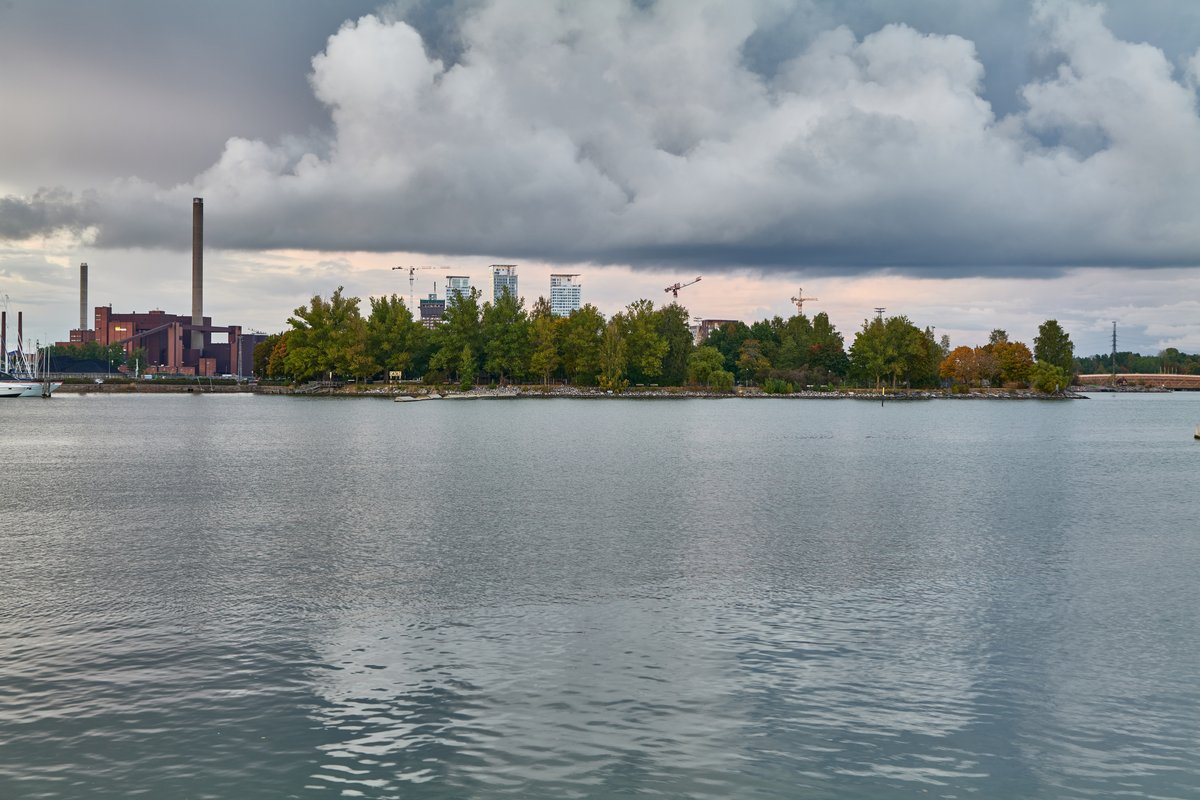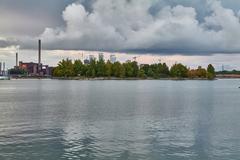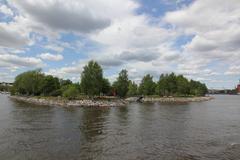
Tervasaari Helsinki: Visiting Hours, Tickets, and Travel Guide
Date: 15/06/2025
Introduction
Tervasaari (“Tar Island”), just off Helsinki’s coast and connected by a pedestrian causeway, is a unique blend of nature, history, and culture. Once a vital industrial hub storing tar for Finland’s maritime trade, it has evolved into a vibrant urban park. Visitors today enjoy lush green spaces, cultural events, and panoramic views of the city, all within walking distance of central Helsinki. This guide details Tervasaari’s history, visiting hours, accessibility, attractions, and practical travel tips, ensuring you have all the information needed for a memorable visit.
For up-to-date information on events and facilities, visit the City of Helsinki’s official website, MyHelsinki, and curated travel platforms such as Lonely Planet.
Table of Contents
- Introduction to Tervasaari: History and Cultural Significance
- Planning Your Visit
- Historical Background and Transformation
- Modern Redevelopment and Community Role
- Visitor Highlights and Activities
- Environmental and Botanical Features
- Urban Planning and Accessibility
- Frequently Asked Questions (FAQ)
- Practical Tips for Visitors
- Explore More: Nearby Attractions
- Visual Media and Interactive Elements
- Conclusion and Final Tips
- References
Introduction to Tervasaari: History and Cultural Significance
Tervasaari’s name reflects its original function: a storage island for tar, a crucial commodity in Finland’s export and shipbuilding industries. The hazardous nature of tar led to its storage on this isolated island, safeguarding the city from fire risks (Vihreät sylit). The island’s transition from industrial use to public park mirrors Helsinki’s commitment to sustainable urban renewal and cultural preservation.
Today, Tervasaari is a beloved green oasis featuring a historic granary, Helsinki’s only dog swimming beach, an amphitheatre for summer performances, and landscaped rose gardens. Its story is woven into the broader narrative of Helsinki’s evolution, offering visitors a living connection to both heritage and contemporary urban life.
Planning Your Visit
Opening Hours
- Park: Open 24 hours a day, year-round.
- Facilities: Seasonal. Playground and dog park generally accessible 6:00–22:00. Restrooms and café are open during the summer months, typically 8:00–22:00.
Tickets
- Admission: Free public access at all times.
- Events: Some amphitheatre performances and special events may require tickets—check the official event calendar for details.
Accessibility
- Flat, paved paths make Tervasaari accessible for wheelchairs, strollers, and bicycles.
- Accessible restrooms are located near the main entrance and playground.
- Some natural and rocky shoreline areas may be less accessible.
Directions & Travel Tips
- On Foot/Bicycle: A 10–15 minute walk or ride from Helsinki’s city center, via the Tervasaarenkannas causeway from Pohjoisranta.
- Public Transport: Tram lines 2, 3, 4, and 5 stop nearby (Hakaniemi and Kruununhaka).
- Parking: Limited street parking along Pohjoisranta; fills quickly in summer.
- Ferry: Seasonal ferries operate from Market Square (Kauppatori) during summer, offering a scenic approach.
Historical Background and Transformation
Industrial Origins
Tervasaari’s earliest documented use dates to 1805, when the first tar granary was built by merchant Petter Heidenstrauch. Its location minimized fire risks to Helsinki’s densely built areas (Vihreät sylit). For over a century, the island served as a secure storage point for tar and other hazardous goods.
Urban Redevelopment
The construction of the Tervasaarenkannas causeway in 1939 connected the island to the mainland, increasing accessibility. After the last cement factory closed in 1970, Helsinki reclaimed land and repurposed Tervasaari as a public park. The transformation was guided by architect Lars Liljefors, whose 1995 redevelopment project introduced diverse plantings, event spaces, and improved infrastructure (Vihreät sylit).
Heritage Preservation
The 1805 wooden tar granary, now a protected structure, stands as a reminder of the island’s industrial heritage. Informational plaques provide context for visitors about the evolution from tar storage to recreational park (Evendo).
Modern Redevelopment and Community Role
Tervasaari is now a vibrant venue for recreation and cultural engagement. Key features include:
- Children’s Playground: Safe, creative, and suitable for all ages.
- Dog Park & Swimming Beach: Fenced enclosures for large and small dogs and Helsinki’s only official dog swimming area.
- Amphitheatre: Hosts open-air theatre, concerts, and community events during summer, with performances by HIT Helsinki (family shows) and Teatteri Helsinki (adult audiences).
- Café-Restaurant: Housed in the historic granary, offering Finnish specialties and sea views in summer.
- Rose Gardens: Featuring varieties such as “Maija Hesperia” and Karelian rose, highlighting Helsinki’s horticultural traditions.
Visitor Highlights and Activities
Guided Tours
Seasonal guided walking tours—bookable via Helsinki tourism—explore Tervasaari’s history and flora.
Events
Summer brings theatre, music, and community festivals to the amphitheatre and open lawns. Flea markets and pop-up food stalls appear periodically.
Photography
Top photo spots include the historic granary, rose gardens in bloom, the mattolaituri (carpet-washing pier), and sweeping cityscape views at sunrise or sunset.
Marina and Boating
The Helsinki Motorboat Club hosts a marina along the causeway. The pier is also used for traditional Finnish rug washing—an authentic local sight.
Environmental and Botanical Features
Tervasaari’s landscaping, completed in the 1990s, emphasizes native flora and biodiversity. The rose gardens, green lawns, and preserved shoreline offer habitats for seabirds and urban wildlife (Vihreät sylit). The mattolaituri pier is a nostalgic nod to Helsinki’s waterfront traditions.
Urban Planning and Accessibility
Tervasaari exemplifies Helsinki’s approach to adaptive reuse and sustainability, turning a former industrial site into a community hub (PlanetWare). Paved paths, accessible facilities, and integration with bike and pedestrian networks make the island welcoming to all visitors.
Frequently Asked Questions (FAQ)
Q: Is there an entrance fee?
A: No; Tervasaari is free and open year-round. Special events may require tickets.
Q: What are the best months to visit?
A: Late spring to early autumn (June–September) sees the most activity, events, and floral displays.
Q: Are dogs allowed?
A: Yes, with designated dog park areas and a dog swimming beach.
Q: Are guided tours available?
A: Yes, seasonally—check with Helsinki Tourist Information.
Q: Is the park accessible?
A: Yes; most paths are flat and paved, suitable for wheelchairs and strollers.
Q: Is swimming allowed?
A: Swimming is permitted at the dog beach for pets, but not for humans due to currents and boat traffic.
Practical Tips for Visitors
- Accessibility: The flat terrain and paved paths allow access for all. Accessible restrooms are available.
- Facilities: Café open late May–early September; bring snacks outside these months.
- Barbecue: Public grills available—bring your own charcoal; open fires prohibited elsewhere.
- Weather: Dress in layers; summer brings long days, while winter paths may be icy.
- Safety: Lifebuoys along the shore; dial 112 in emergencies.
- Etiquette: Moderate alcohol allowed; respect local customs and keep noise down after 22:00.
Explore More: Nearby Attractions
- Kruununhaka District: Charming streets and cafés.
- Helsinki Cathedral: Iconic landmark, 15 minutes’ walk away.
- Market Square (Kauppatori): Harbor market with Finnish foods and crafts.
- Suomenlinna Fortress: UNESCO World Heritage Site, accessible by ferry.
- Sibelius Park: Another green space ideal for strolls and relaxation.
Visual Media and Interactive Elements
- Visit MyHelsinki for high-quality images of Tervasaari’s vistas, playgrounds, and dog park.
- Alt tags include keywords like “Tervasaari visiting hours” and “Helsinki historical sites.”
- Interactive maps and virtual tours are available on official tourism sites.
Conclusion and Final Tips
Tervasaari encapsulates Helsinki’s spirit of adaptive urbanism—transforming from a crucial industrial outpost to a thriving park that celebrates history, nature, and community. With year-round free access, inclusive amenities, and a calendar of cultural events, it stands out as both a tranquil retreat and a lively gathering place. For the fullest experience, visit in summer, explore the granary and gardens, or attend a performance at the amphitheatre.
For personalized guides, event listings, and real-time updates, download the Audiala app and connect with Helsinki’s rich cultural scene. Share your #Tervasaari moments on social media and discover more of Finland’s historical treasures.
References
- Tervasaari Helsinki: Visiting Hours, Tickets, and Historical Insights, 2025, Vihreät sylit (https://vihreatsylit.fi/tervasaari/)
- Visiting Tervasaari in Helsinki: Hours, Tickets, and Cultural Highlights, 2025, Lonely Planet and PlanetWare (https://www.lonelyplanet.com/finland/helsinki/attractions), (https://www.planetware.com/tourist-attractions-/helsinki-helsingfors-sf-udn-hels.htm)
- Tervasaari Helsinki: Visiting Hours, Tickets, and Top Attractions, 2025, MyHelsinki (https://www.myhelsinki.fi/places/tervasaari/)
- Tervasaari Visiting Hours, Tickets, and Practical Tips for Exploring Helsinki’s Historic Island, 2025, The Broke Backpacker and Lonely Planet (https://www.myhelsinki.fi/visit/helsinki-tourist-information/), (https://www.thebrokebackpacker.com/best-places-to-visit-in-helsinki/)
- Additional attraction information: Evendo





























































































































































































































